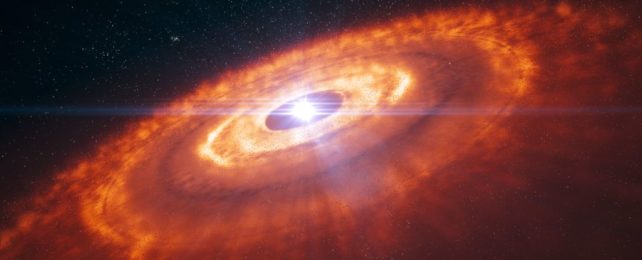Tiny fragments of rock brought back from an asteroid in near-Earth solar orbit are so old, they predate the Solar System.
A new analysis of samples of asteroid Ryugu has revealed the presence of mineral grains forged in the outflows or explosions of old stars before our own Sun formed.
As identified by previous research, these presolar grains reveal Ryugu is very similar to a class of meteorites known as Ivuna-type carbonaceous (CI) chondrites. However, the presence of some fragile grains indicate that parts of Ryugu may be unchanged since the asteroid formed.
"The samples returned from asteroid Ryugu by the Hayabusa2 spacecraft contain presolar stardust grains. Their abundances and compositions are similar to presolar material found in CI chondrites. Thus, our results provide further evidence that asteroid Ryugu is closely related to CI chondrites," the researchers write in their paper.
"However, small regions of Ryugu escaped extensive alteration and allowed their preservation."
The preservation of the isotope ratios in presolar grains makes them highly valued as snapshots of processes that occur in distant stars; as such, they are a direct record of those stars and their chemistry. They can be used to understand the evolutionary processes of stars other than the Sun, as well as the Solar System rocks they become bound up in.
Presolar grains are also incredibly rare. They're typically found in carbonaceous chondrites, which constitute a small percentage of all meteorites that fall to Earth. What's more, only around 5 percent of carbonaceous chondrites have been found to contain presolar grains. The oldest one to date is between 5 and 7 billion years old, compared to the 4.6 billion-year age of the Sun.
A couple of previous studies identified some presolar grains in material from Ryugu. Now, a huge international team led by cosmochemist Jens Barosch of the Carnegie Institution of Washington has conducted a comprehensive search, and found a whopping 57 grains with presolar isotope ratios.
The team compared these grains with grains found in meteorites, and found that Ryugu's makeup is very similar to that of CI chondrites. These are a rare subtype of carbonaceous chondrites, with the most similar chemical composition to the Sun seen in meteorites, and significant amounts of water.
The mineralogy of the Ryugu samples indicate that extensive aqueous alteration has taken place during water-rock interactions on the Ryugu parent body. And this is where things get interesting – because at least one of the grains discovered by the team is a presolar silicate. Since silicates are easily destroyed during aqueous alteration, this finding was "particularly unexpected," the researchers say.
Presolar silicates are therefore probably restricted to relatively rare sections, or clasts, of the rock that are less altered than the overall matrix of Ryugu, consisting of minerals that contain no water. As a result, these clasts are able to preserve delicate grains that would not otherwise survive.
Similar water-free clasts in other CI meteorites – including Ivuna, which gives the class its name – that have yet to be analyzed could reveal other such delicate presolar grains, the researchers say.
"The presence or absence of presolar material in these clasts would provide important clues about their origin and their history of secondary processing," they write in their paper.
Meanwhile, "Systematic searches for presolar grains in all Ryugu lithologies will provide a representative data set of presolar grain abundances and characteristics in asteroid Ryugu and will extract the maximum scientific information from these precious samples."
The research has been published in The Astrophysical Journal Letters.
